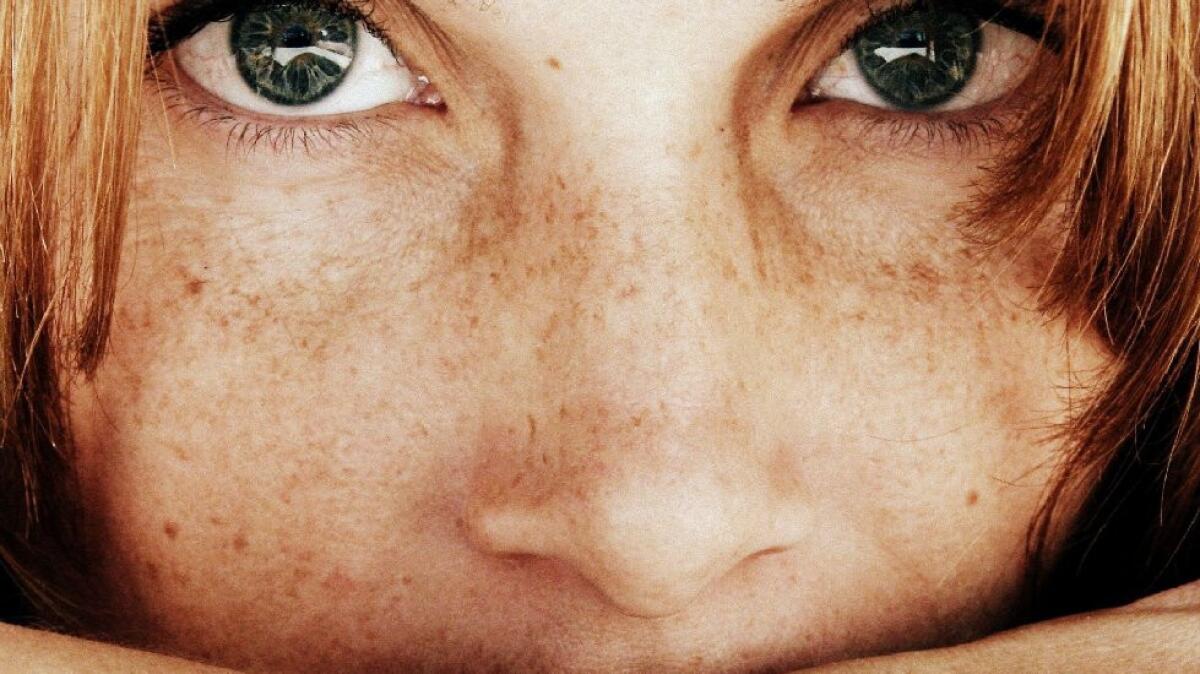A genetic link between red hair, freckles and skin cancer

Whether you call them gingers, the devil’s spawn or just-plain sexy, be sure to call redheads out of the sun because along with their fiery tresses comes a powerful propensity to develop melanoma, a particularly deadly form of skin cancer.
And now, scientists are beginning to uncover why redheads — and probably the non-gingers who carry a genetic variant common to redheads — may be so vulnerable: For those who carry an allele, or gene variant, associated with red hair and freckles, cancer-causing genetic mutations occur at a rate 42% greater than they do for people who don’t carry that gene variant.
As a result, the average carrier of at least one problematic variant of the melanocortin 1 receptor, or MC1R, gene tends to develop cancer-promoting mutations at roughly the same rate as a person 21 years her senior.
And that’s despite the known tendency of such people to avoid spending days in the sun, a factor known to initiate cellular changes leading to skin cancer.
Redheads comprise an estimated 1% to 2% of the world’s population, and as much as 10% to 13% of the population in Scotland and Ireland, respectively. But they make up 16% of the world’s population of melanoma patients.
At the same time, 26% to 40% of melanoma patients are carriers of at least one R allele of the MC1R gene, which, because it is recessive, will not always result in redheadedness and freckling. So, physicians treating people with red hair or a tendency to freckle, or whose parents did, have long been aware that something was up.
In a study published Tuesday in the journal Nature Communications, an international team led by cancer geneticists from the United Kingdom’s Sanger Institute scoured the “germline” genes of 273 melanoma patients (more or less, the DNA carried by all of their cells over a lifetime) for evidence of their MC1R carrier status. Then, they sequenced the genes of the 343 tumors taken from those patients for evidence of “somatic” mutations. Somatic mutations are changes to the underlying germline genes that exist only in the tumor sample and are therefore thought to play some role in cancer initiation or growth.
Just over half of the patients whose genes were queried were people who did not carry even a single copy of the MC1R gene’s problematic R allele. Most of the rest were single-allele carriers, meaning they were not likely classic redheads but had inherited a copy of the gene variant from a parent who was. Just 28 of the 273 individuals whose tumors were genetically sequenced carried two of the R alleles linked to redheadedness.
When they compared the somatic mutations in the tumors that came from these populations, researchers saw a clear pattern: Tumors taken from carriers of one or both R alleles, which researchers lumped together as a single group, had many more mutations than did those taken from melanoma patients who were not carriers at all. In carriers of the MC1R variants, even non-cancerous cells appeared to accumulate mutations more readily, the researchers found.
These findings suggest how it is that redheads and their fellow carriers of an R allele might be more likely than noncarriers to develop melanoma. Any of those mutations found in a patient’s tumor can play a role in allowing cancer to gain a foothold, driving its growth or preventing DNA-repair genes from stepping in and correcting some other problematic mutation. In principle, the more mutations a tumor has, the more likely it is to become deadly.
That, says Emory University melanoma expert Dr. Brian P. Pollack is a reasonable inference for researchers to make. But Pollack, who was not involved with the current study, cautioned that not all of a tumor’s somatic mutations are bad news: Increasingly, as researchers pursue immunologic therapies for cancers such as melanoma, they are finding that some somatic mutations might be helpful, unmasking a tumor to the immune system as a foreign threat.
NEWSLETTER: Get the day’s top headlines from Times Editor Davan Maharaj »
Pollack added that it will take further research to establish whether carriers of a single R allele — people who likely had at least one parent with red hair and freckles but who do not exhibit that trait themselves — are actually just as vulnerable to developing melanoma as are redheads who carry both alleles.
“This is a very important question raised by this study,” said Pollack. If melanoma risk is equally elevated for carriers of a single MC1R allele and for redheads who carry two such variants, “should dermatologists and other healthcare providers ask patients if they have a parent with red hair?” he asked.
Follow me on Twitter @LATMelissaHealy and “like” Los Angeles Times Science & Health on Facebook.
MORE IN SCIENCE
In predicting a stroke’s toll, location matters, but so do connections
Science proves it: Girl Scouts really do make the world a better place




